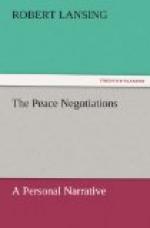CHAPTER XVII
SECRET DIPLOMACY
Another matter, concerning which the President and I disagreed, was the secrecy with which the negotiations were carried on between him and the principal European statesmen, incidental to which was the willingness, if not the desire, to prevent the proceedings and decisions from becoming known even to the delegates of the smaller nations which were represented at the Peace Conference.
Confidential personal interviews were to a certain extent unavoidable and necessary, but to conduct the entire negotiation through a small group sitting behind closed doors and to shroud their proceedings with mystery and uncertainty made a very unfortunate impression on those who were not members of the secret councils.
At the first there was no Council of the Heads of States (the so-called Council of Four); in fact it was not recognized as an organized body until the latter part of March, 1919. Prior to that time the directing body of the Conference was the self-constituted Council of Ten composed of the President and the British, French, and Italian Premiers with their Secretaries or Ministers of Foreign Affairs, and two Japanese delegates of ambassadorial rank. This Council had a membership identical with that of the Supreme War Council, which controlled the armistices, their enforcement, and other military matters. It assumed authority over the negotiations and proceedings of the Conference, though it was never authorized so to do by the body of delegates. The Council of Four, when later formed, was equally without a mandate from the Conference. They assumed the authority and exercised it as a matter of right.




